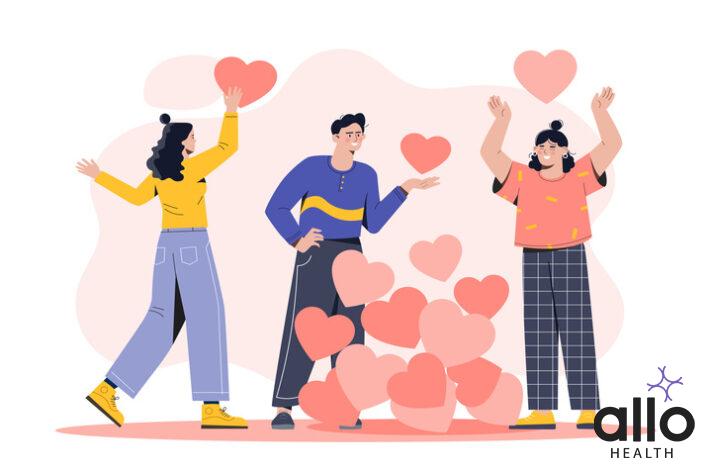Unpacking Intersex: Understanding and Celebrating Diversity

Allo Health is dedicated to personalized well-being, offering support and trusted information tailored to individual health goals. The platform emphasizes human-generated content, led by a distinguished medical team of experts, including physicians and sexual health specialists. Their commitment to credibility involves rigorous fact-checking, authoritative research, and continuous updates to ensure accurate, up-to-date information. Allo Health's unique approach goes beyond conventional platforms, providing expert-led insights and a continuous commitment to excellence, with user feedback playing a crucial role in shaping the platform's authoritative voice.

Dr. Aditi completed her undergraduate medical education at AJIMS, Mangalore, after which she worked in multi-speciality hospitals with COVID patients and in the Pain and Palliative medicine department. Driven by her experiences, she developed a keen interest in psychiatry. Dr. Aditi believes that mental health is just as, if not more important, than physical health.
Why This Was Upated?
Our experts continually monitor the health and wellness space, and we update our articles when new information became available.
Updated on 22 February, 2024
- Article was updated as part of our commitment to diversity, equity, and inclusion.

"The following blog article provides general information and insights on various topics. However, it is important to note that the information presented is not intended as professional advice in any specific field or area. The content of this blog is for general educational and informational purposes only.
Book consultation
The content should not be interpreted as endorsement, recommendation, or guarantee of any product, service, or information mentioned. Readers are solely responsible for the decisions and actions they take based on the information provided in this blog. It is essential to exercise individual judgment, critical thinking, and personal responsibility when applying or implementing any information or suggestions discussed in the blog."
In a world filled with diverse identities, it is crucial to foster understanding and compassion for all individuals. One such identity that often remains misunderstood is intersex. Intersex is a term used to describe individuals who are born with physical or biological sex characteristics that do not fit typical binary notions of male or female.
Disclaimer: This article provides general information and understanding of the term “intersex.” It is not intended as medical advice or a substitute for professional guidance. If you have specific concerns or questions regarding yourself or someone you know, it is advisable to seek assistance from qualified professionals or LGBTQ+ organizations.
What Is Intersex?
Intersex describes individuals who are born with variations in their physical sex characteristics that do not fit typical definitions of male or female. Intersex is a natural variation of human biology, and it occurs in approximately 1 in 2,000 to 1 in 4,500 births, although the exact prevalence is difficult to determine due to varying definitions and classifications.
Intersex traits can manifest in different ways. Some intersex individuals may have ambiguous genitalia, meaning their external genitals may not clearly resemble typical male or female genitalia. Others may have atypical internal reproductive organs, such as variations in the structure of the uterus, fallopian tubes, or testes.
It is important to note that intersex is distinct from gender identity or sexual orientation. Gender identity refers to an individual’s deeply held sense of being male, female, or something else, while sexual orientation refers to an individual’s romantic or sexual attraction to others.
Intersex variations are believed to arise from a combination of genetic, hormonal, and environmental factors during fetal development. They are not considered disorders or diseases but rather natural variations of human biology. Intersex traits can be discovered at birth or later in life, depending on the specific characteristics and individual circumstances.
The medical management of intersex traits has evolved over time. In the past, there was a tendency to surgically assign a male or female gender to intersex infants, often without their informed consent. These surgeries were primarily aimed at conforming the child’s appearance to societal expectations of male or female. However, there has been a growing movement advocating for more autonomy and bodily integrity for intersex individuals, calling for an end to non-consensual surgeries unless they are medically necessary.
Intersex rights and advocacy organizations work to raise awareness about intersex variations, promote acceptance, and advocate for the rights of intersex individuals. They aim to challenge harmful stigmas, discrimination, and unnecessary medical interventions, and to ensure intersex people have access to appropriate healthcare, support, and legal protections.
It is important to approach the topic of intersex with sensitivity, respect, and an understanding that everyone’s experiences and needs may vary.
Intersex Terminology
Understanding and using appropriate terminology is crucial when discussing intersex issues. Here are some key terms related to intersex:
- Variation/Difference of Sex Development (DSD): Some individuals and organizations prefer using the term “Difference of Sex Development” or DSD instead of intersex. DSD is a medical term used to describe a range of conditions where there are atypical chromosomal, gonadal, or anatomical variations related to sex development.
- Ambiguous Genitalia: Ambiguous genitalia refers to external reproductive organs that do not exhibit clear male or female characteristics at birth. This term is sometimes used to describe intersex infants whose genitalia are not easily classified as typically male or female.
- Gonads: Gonads are the reproductive organs that produce gametes (sperm or eggs) and hormones. In typical development, testes develop in males, and ovaries develop in females. In intersex individuals, gonadal development may be atypical, and they may have variations such as ovotestes or atypical testes or ovaries.
- Chromosomes: Chromosomes are structures within cells that carry genetic information. Typically, males have one X and one Y chromosome (XY), while females have two X chromosomes (XX). Intersex individuals may have variations in their sex chromosomes, such as XXY, XO, or other combinations.
- Non-consensual Intersex Medical Interventions: Historically, some intersex infants underwent non-consensual surgical interventions to modify their genitalia to fit a binary male or female appearance. These interventions are now widely criticized, and there is growing recognition of the importance of informed consent and the rights of intersex individuals to make decisions about their own bodies.
- Gender Identity: Gender identity refers to an individual’s deeply held sense of their own gender, whether that aligns with their assigned sex at birth or not. Gender identity is distinct from biological sex and is a deeply personal and individual experience.
- Gender Dysphoria: Gender dysphoria refers to the distress experienced by individuals whose gender identity does not align with the sex assigned to them at birth. While some intersex individuals may also experience gender dysphoria, it is important to recognize that not all intersex people identify as transgender or experience gender dysphoria.
- Intersex Rights and Advocacy Organizations: Various organizations around the world work to promote the rights and well-being of intersex individuals. These organizations focus on raising awareness, providing support, advocating for legal protections, and challenging harmful practices.
It is essential to respect individuals’ preferences regarding terminology and to recognize the diversity of experiences within the intersex community. Using inclusive language and being open to learning from intersex voices can contribute to creating a more inclusive and supportive society.
Common Intersex Variations
Intersex variations encompass a wide range of conditions and characteristics. Here are some common intersex variations, each with its own unique characteristics:
- Androgen Insensitivity Syndrome (AIS): AIS is a condition where individuals with XY chromosomes have reduced or complete insensitivity to androgens (male sex hormones) in their bodies. As a result, their external genitalia may appear typically female or have some degree of ambiguity, while their internal reproductive organs are typically male (undescended testes or testes that resemble ovaries). Individuals with AIS are often assigned females at birth.
- Congenital Adrenal Hyperplasia (CAH): CAH is a group of conditions that affect the adrenal glands, leading to an overproduction of androgens. Depending on the severity of the condition, individuals with CAH may have varying degrees of atypical genitalia. In severe cases, individuals with XX chromosomes may have external genitalia that appears more masculinized, while those with XY chromosomes may have genitals that appear typically male.
- Klinefelter Syndrome: Klinefelter Syndrome is when individuals have an extra X chromosome (XXY instead of XY). Individuals with Klinefelter Syndrome often have testes that do not function fully, resulting in lower testosterone levels and potential fertility issues. They may have physical traits such as taller stature, increased breast tissue, and less body and facial hair compared to typically male individuals.
- Turner Syndrome: Turner Syndrome occurs in individuals with only one X chromosome (X instead of XX or XY). It typically affects individuals assigned ‘female’ at birth, and they may have shorter stature, underdeveloped ovaries, and various other physical features such as a webbed neck and lymphedema. Fertility is typically affected.
- 5-alpha Reductase Deficiency: 5-alpha reductase deficiency is a condition where individuals with XY chromosomes have difficulty converting testosterone into dihydrotestosterone (DHT), resulting in varying degrees of genital ambiguity at birth. Some individuals with this condition may be assigned female at birth and later develop typically male secondary sexual characteristics during puberty.
- Complete Androgen Insensitivity Syndrome (CAIS): CAIS is a subtype of AIS where individuals with XY chromosomes are completely insensitive to androgens. They typically have female external genitalia and often identify as women. Their internal reproductive organs consist of testes, which are usually removed surgically due to the risk of cancer, but they do not have a uterus or ovaries.
These are just a few examples of intersex variations, and it is important to remember that intersex is a spectrum with numerous other conditions and combinations of biological traits. Each individual’s experience and medical needs can be unique, and it is crucial to approach intersex variations with sensitivity, respect, and understanding.
Reproductive Anatomy
The reproductive anatomy of intersex individuals can vary significantly depending on the specific intersex variation they have. Intersex individuals may have atypical chromosomal, gonadal, or anatomical characteristics that affect their reproductive system. Here are some key aspects to consider:
- Gonads: Intersex individuals may have variations in their gonads, which are the reproductive organs responsible for producing gametes (sperm or eggs) and sex hormones. Gonadal variations can include atypical testes, ovaries, or a combination of both (ovotestes). The development and functionality of gonads can vary greatly, and they may be located in different parts of the body, including the abdominal cavity or within the inguinal canal.
- Internal Reproductive Organs: The internal reproductive organs, including the uterus, fallopian tubes, and cervix in females, and seminal vesicles and vas deferens in males, can also exhibit variations in intersex individuals. Some intersex individuals may have a combination of typically male and female reproductive organs, while others may have underdeveloped or absent structures. The presence and functionality of these organs depend on the specific intersex condition.
- External Genitalia: The external genitalia of intersex individuals can vary widely and may not fit traditional definitions of male or female genitalia. Some intersex individuals may have ambiguous genitalia, where the external reproductive structures do not clearly resemble typical male or female genitalia. This can include variations in the size, shape, or placement of the genitals. The external appearance of the genitalia in intersex individuals can be influenced by hormonal factors during development.
- Secondary Sexual Characteristics: Intersex individuals may also exhibit variations in secondary sexual characteristics, such as breast development, body hair patterns, and voice pitch. The development and manifestation of secondary sexual characteristics can be influenced by hormonal factors, including the levels of androgens (male sex hormones) and estrogens (female sex hormones) in the body.
Challenges Faced by Intersex Individuals

Intersex individuals often face unique challenges due to societal misunderstandings and stigmatization. These challenges can include:
- Stigma and Discrimination: Intersex individuals often encounter societal stigma and discrimination due to a lack of understanding and awareness about intersex variations. They may face prejudice, misunderstanding, and negative attitudes from others, including healthcare providers, educators, and the general public. This can lead to feelings of shame, isolation, and a sense of not belonging.
- Non-consensual Medical Interventions: Historically, intersex infants and children have been subjected to non-consensual surgical interventions aimed at “normalizing” their genitalia to conform to societal expectations of binary male or female anatomy. These surgeries, often performed without the informed consent of the individual, can have significant physical and psychological consequences. There is a growing movement advocating for the end of unnecessary and non-consensual interventions, supporting the rights of intersex individuals to make decisions about their own bodies.
- Lack of Informed and Affirming Healthcare: Intersex individuals may face challenges in accessing appropriate healthcare that is knowledgeable and sensitive to their unique needs. Many healthcare providers have limited awareness and training about intersex variations, which can result in misdiagnosis, inappropriate treatment, and a lack of support. Intersex individuals often require specialized care that respects their bodily autonomy, supports their physical and mental well-being, and provides accurate and comprehensive information.
- Mental Health Issues: Intersex individuals may experience higher rates of mental health challenges such as depression, anxiety, and post-traumatic stress disorder (PTSD). These issues can stem from the experience of stigma, discrimination, and negative body image. The psychological impact of non-consensual medical interventions and a sense of being different or not fitting societal norms can contribute to emotional distress.
- Identity and Disclosure: Intersex individuals may face challenges in understanding and exploring their own identities. The experience of being assigned a sex at birth that does not align with their internal sense of self can lead to confusion and identity struggles. Deciding when and how to disclose their intersex status to others can also be complex, as they navigate concerns about privacy, potential reactions, and the impact on their relationships.
- Legal Protections and Recognition: Intersex individuals may face challenges in obtaining legal recognition and protections that acknowledge their specific needs. Some countries lack specific legal provisions addressing intersex rights, leading to a lack of protection against discrimination, limited access to healthcare, and difficulties in obtaining accurate identification documents.
Addressing these challenges requires broader societal awareness, education, and policy changes. Supporting intersex individuals includes promoting acceptance, ending non-consensual medical interventions, providing informed and affirming healthcare, and advocating for legal protections and recognition of intersex rights. It is crucial to create an inclusive and supportive environment that celebrates the diversity of human bodies and respects the autonomy and well-being of intersex individuals.
Creating an Inclusive Society
Creating an inclusive society for intersex individuals requires collective efforts to promote understanding, acceptance, and equal rights. Here are some key aspects to consider:
- Education and Awareness: Promoting education and awareness about intersex variations is essential to combat stigma and misconceptions. This includes incorporating accurate and inclusive information about intersex variations in school curricula, training healthcare providers and educators about intersex issues, and raising public awareness through campaigns, media, and community outreach.
- Respect for Autonomy and Informed Consent: Respecting the autonomy and bodily integrity of intersex individuals is crucial. This means ensuring that any medical interventions are based on informed consent and are medically necessary rather than driven by societal expectations. Supporting intersex individuals in making decisions about their own bodies and empowering them to have a voice in their healthcare is essential.
- Inclusive Healthcare: Healthcare providers should receive education and training on intersex variations to provide knowledgeable and affirming care. This includes creating specialized clinics or teams that understand intersex issues, offering comprehensive and accurate information to individuals and their families, and providing access to mental health support to address the unique challenges faced by intersex individuals.
- Legal Protections: Advocating for legal protections that recognize the rights of intersex individuals is crucial. This includes ensuring protection against discrimination based on intersex status, promoting the right to bodily integrity and self-determination, and addressing the specific needs of intersex individuals in areas such as identification documents, healthcare, and education.
- Support Networks and Mental Health Services: Establishing support networks and mental health services specifically tailored to the needs of intersex individuals can provide invaluable assistance. Peer support groups, counselling services, and online communities can create safe spaces for intersex individuals to share experiences, seek guidance, and build a sense of belonging.
- Collaboration with Intersex Organizations: Working closely with intersex advocacy and support organizations is essential to ensure that the voices and experiences of intersex individuals are heard and respected. Collaborating with these organizations can help shape inclusive policies, provide resources and support, and ensure that the needs and rights of intersex individuals are prioritized.
- Promoting Inclusive Language and Representation: Using inclusive language that respects the diversity of intersex experiences is important. This includes using accurate and respectful terminology, avoiding stigmatizing language, and recognizing that intersex is a natural and valid variation of human diversity. Encouraging media representation that portrays intersex individuals in a positive and accurate light can also foster understanding and acceptance.
FAQs
- How common is intersex? The exact prevalence of intersex variations is not well-established due to factors such as different classifications and diagnostic criteria. Estimates vary, but it is generally believed that intersex conditions are relatively rare, affecting around 1 in 2,000 to 1 in 4,500 births.
- Are intersex individuals transgender? Intersex and transgender are distinct and separate concepts. Intersex refers to variations in physical sex characteristics, while transgender relates to an individual’s gender identity, which may not align with the sex assigned to them at birth. While some intersex individuals may also identify as transgender, not all intersex individuals do, and gender identity is a deeply personal experience.
- Are intersex variations considered a medical condition? Intersex variations are not inherently pathological or medical conditions. They are natural variations of human biology. However, some intersex individuals may require medical attention to address specific health concerns or to support their well-being.
- Can intersex variations be detected at birth? In some cases, intersex variations can be identified at birth when the external genitalia appear atypical. However, not all intersex variations are apparent at birth, and some may only become evident during puberty or later in life.
Creating an inclusive society for intersex individuals requires ongoing efforts to challenge societal norms, promote education and awareness, and advocate for legal and policy changes. It is crucial to centre the voices and experiences of intersex individuals themselves in these efforts, ensuring that their rights, autonomy, and well-being are at the forefront of the movement toward inclusivity.
Understanding intersex is an essential step towards creating a more inclusive and empathetic society. By dispelling myths and misconceptions, promoting respectful language, and advocating for the rights and autonomy of intersex individuals, we can foster an environment that embraces human diversity. Remember, intersex is not an issue or a problem; it is a natural variation of human biology that deserves acceptance, support, and celebration.






































